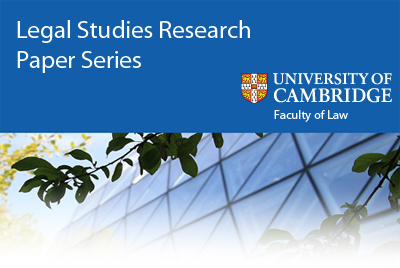 The Faculty has published Volume 4 Number 6 of the University of Cambridge Faculty of Law Legal Studies Research Paper Series on SSRN.
The Faculty has published Volume 4 Number 6 of the University of Cambridge Faculty of Law Legal Studies Research Paper Series on SSRN.
This issue includes the following articles:
Catherine Barnard: The Charter, the Court - and the Crisis (18/2013)
The incorporation of the Charter of Fundamental Rights into the EU Treaties is the most profound Constitutional change in the EU in the last decade. It has created a seismic shift in the attitude of the Court of Justice to the Charter of Fundamental Rights and to human rights more generally. This has led to some key decisions, in cases such as Volker and Schecke and Test-Achats, where the Court has declared EU legislative provisions contrary to the Charter. In other cases the strong hand of the Charter can be felt orientating the direction of travel of the reasoning and the final.
Yet the same Court, in Pringle, has said that the conclusion of the European Stability Mechanism Treaty did not infringe the principle of effective judicial protection under Article 47 of the Charter because 'the Member States are not implementing Union law, within the meaning of Article 51(1) of the Charter, when they establish a stability mechanism such as the ESM where the [TEU and TFEU] do not confer any specific competence on the Union to do so'. The same may apply to the Treaty on Stability, Coordination and Governance (TSCG), since it, too, is an agreement between 25 Member States and not (yet) part of EU law. More generally, the Court has so far refused to apply the Charter to national measures which have been taken as part of the conditionality for 'bail-outs' granted by EU/IMF and national funds.
This suggests a developing twin-track approach: on the one hand the Charter will be applied with vigour to non-crisis situations; on the other, the Charter will not be applied to rules arising out of the EU's response to the financial and economic crisis. Ultimately, such an approach, with crisis related measures in the slow lane, is not legally, politically or practically sustainable. While it is understandable that the Court does not wish to jeopardise the political compromises - some drawn up with great care, others hurriedly pulled together in the middle of the night - necessary to respond to the crisis, the tools it has used to ring fence such measures from the scrutiny of EU law, and the Charter in particular, have been pretty blunt. Further, a closer examination of the terms of the TSCG suggest that the stark dichotomy between EU law, to which the Charter will apply, and non-EU law, to which it will not, cannot be sustained in the longer term. If this is correct, this raises the question as to how the Court might decide to apply the Charter to such politically sensitive issues.
This paper is structured as follows. It will begin by arguing in section B that the Charter's arrival has in areas not directly related to the crisis already had a profound effect on the EU's legal and political scene. This section will distinguish between three, overlapping effects of the Charter: (1) direct impact, where the Charter has resulted in concrete reforms to EU and national law; (2) indirect impact, where the Charter has steered the development of other rules and possibly precipitated a reconsideration of earlier hierarchies; and (3) shadow effect, where the Charter itself is not cited but the decision can be understood against the backcloth of the Charter.
Second, the paper will turn to examine, 'crisis-related' situations where the Charter has, so far, had little impact, namely the reforms to national labour law required by the troika in the wake of the financial crisis (section C). It will then consider whether the Charter might apply to measures adopted under the ESM and TSCG. Finally, it will examine how the Court might apply the Charter when it eventually comes to hear a challenge to a national reform under the Charter. Section D concludes.
Martin Dixon: To Write or Not to Write (20/2013)
Land registration, formalities, and land registry forms. Considers the need for writing for dispostions of an interest in land and the new Land Registry form - form JO.
Sahbi Singh: International Law as a Technical Discipline: Critical Perspectives on the Narrative Structure of a Theory (22/2013)
This is an extended review (26 pages) of Jean d'Aspremont's monograph - Formalism and the Sources of International Law (2011). This paper has two purposes: (1) to examine the virtues and failings of a Hartian approach to international law; and (2) to analyse the narrative necessities and structure of theories (here, formalism) with a view to commenting on the politics of theory within the academy.
In regards (1), I examine the intellectual conditions in which the turn to formalism (and in d'Aspremont's context, a narrow positivism) has emerged within Europe. In this context I look at how and why the turn has been necessitated by the Law & Economics movement within US variants of international law. I then consider the fragilities of a Hartian approach given: (a) its pathological desire for relative determinacy and methodological empiricism; (b) its belief that law's normativity is intimately intertwined with determinacy; (c) that its social scientific empiricism is based on a circular logic which excludes the functioning of theory; and (d) its reductive approach to how meaning is produced. None of these detract from the intellectual necessity of d'Aspremont's book and his theoretical call. I also consider the book's approach - in terms of rupture and consistency - alongside d'Aspremont's broader project on international legal positivism and his subsequent forays into theory.
In regards (2), I structure the paper to imitate the narrative structure of the book and look at the rhetorical and intellectual manoeuvres used by theorists so that they may appear to posit coherent visions of the world. In this sense it is a paper that briefly examines the politics of theory within the academy - where theory is considered as merely an aesthetic. The manoeuvres examined include: (a) intellectual specialisation; (b) the claim to bring order, coherence and reason to an area of thought riddled with incoherence and disorder; (c) the insulation of theoretical positions against critique using Kuhn's 'paradigm' approach to theory; and (d) the elevation of coherence in thought, over different pieces of work, above ruptures in theoretical thought.
Daniel Bates: Are 'Digital Natives' Equipped to Conquer the Legal Landscape? (26/2013)
There is no doubt that the 'Google Generation' or 'Digital Natives' are entering legal education with a very different set of skills that those who came before them. In this article, Daniel Bates examines the precise nature of the skillset of modern beginning their legal careers, and considers his experiences teaching research skills to law students at the University of Cambridge for over a decade. Further, he considers how students' educational and cultural background in the areas of research and information literacy should inform the teaching of legal skills.
Interested readers can browse the Working Paper Series at SSRN, or sign up to subscribe to distributions of the the e-journal.


 Facebook
Facebook  X/Twitter
X/Twitter  Instagram
Instagram  YouTube
YouTube  Flickr
Flickr  LinkedIn
LinkedIn